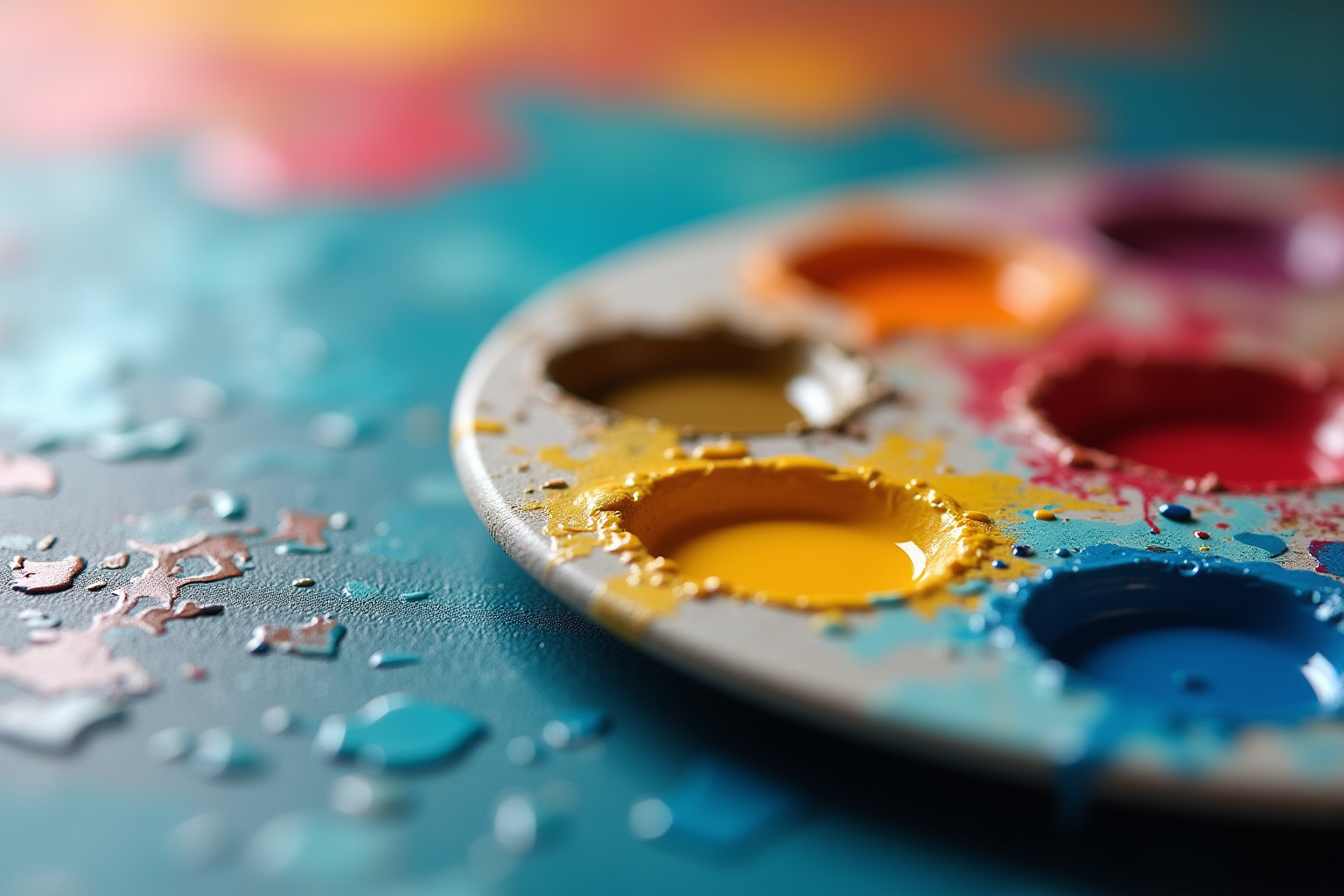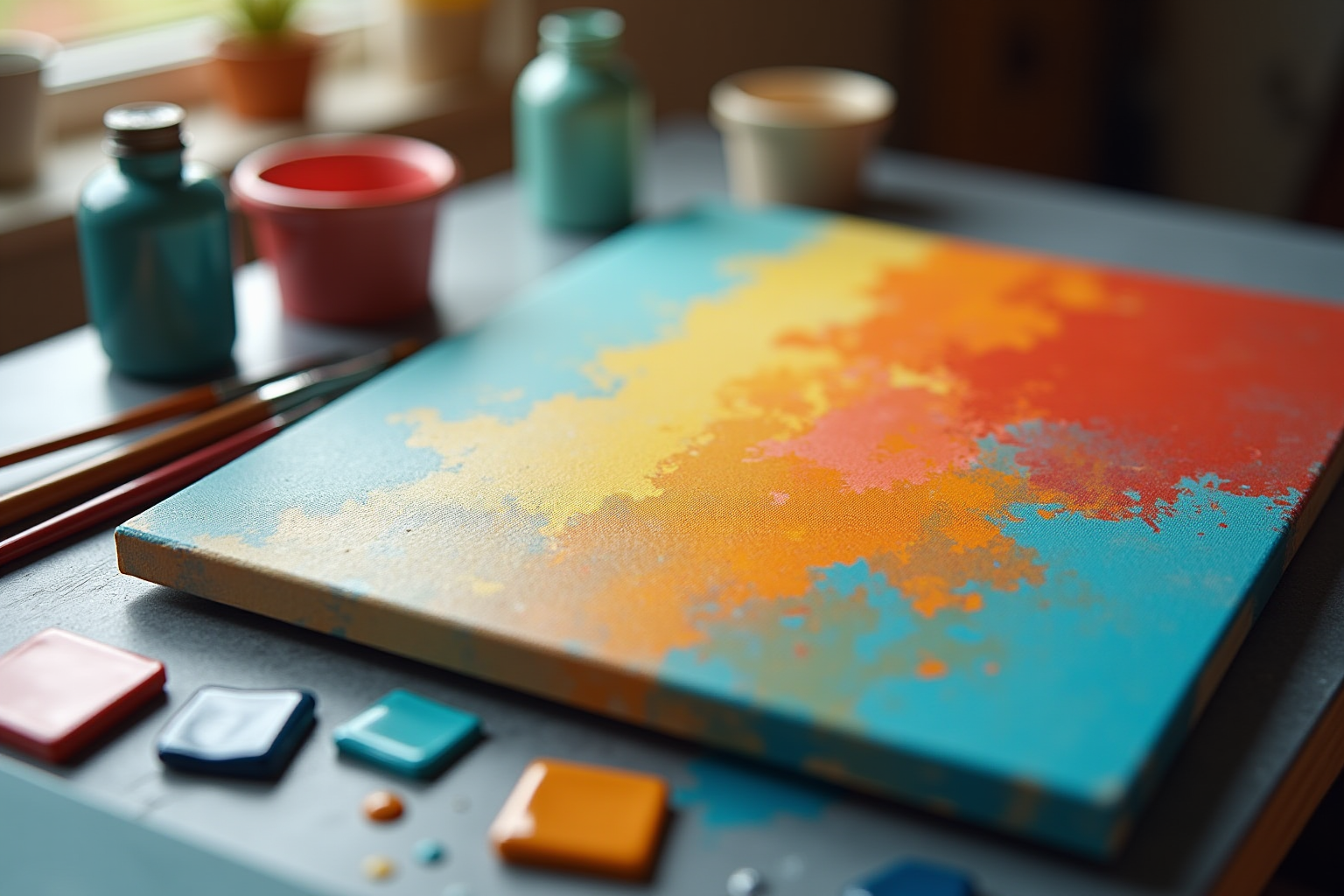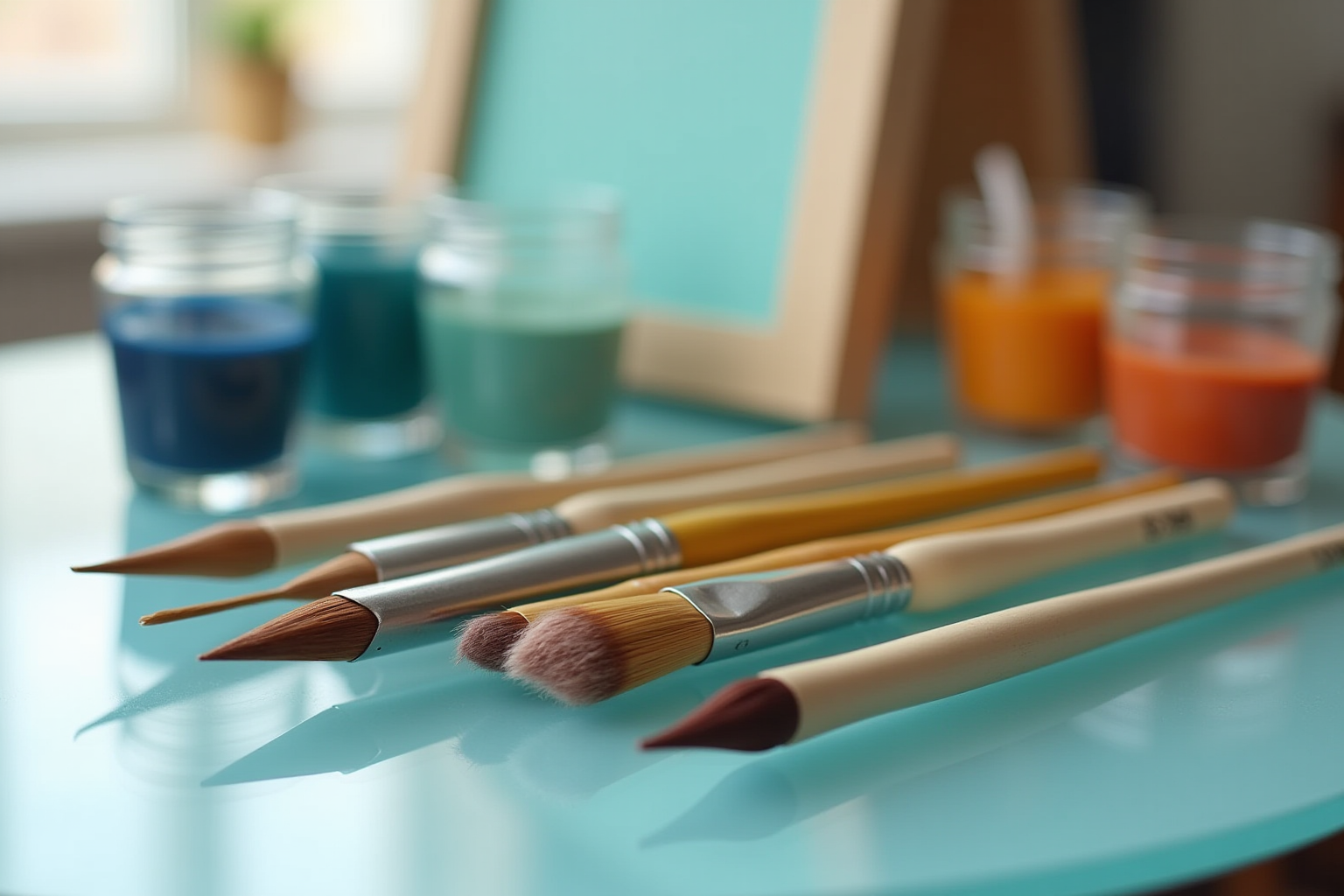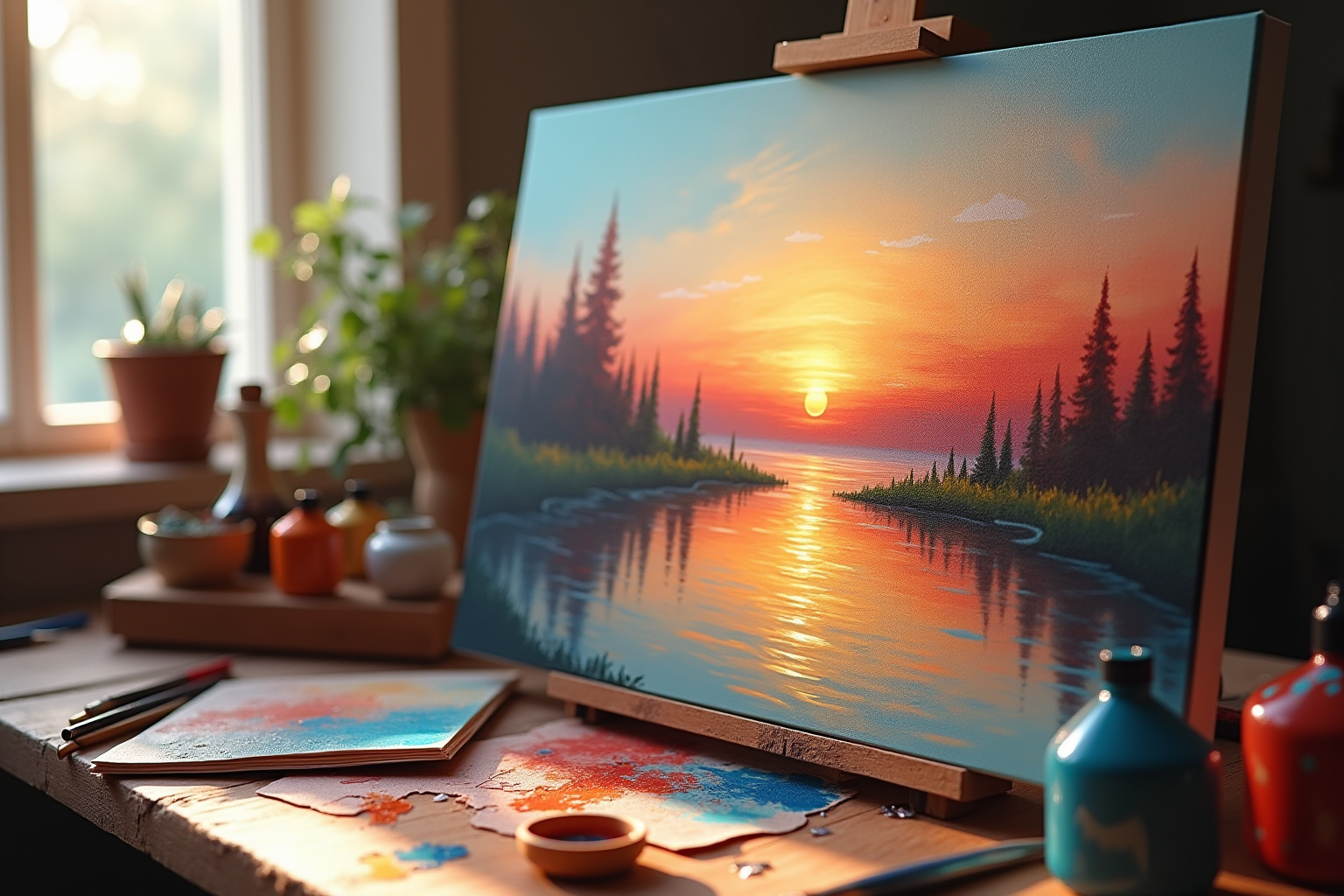Glazing Techniques for Oil Paintings

Unlocking the Radiance: The Art of Glazing in Oil Painting
Imagine a canvas shimmering with depth, a luminous quality that ignites the imagination and captivates the eye—a masterpiece that seems to pulse with life. This enchanting effect can be achieved through the exquisite technique known as glazing in oil painting. This method relies on the strategic layering of thin, transparent washes of color. By understanding and mastering oil paint glazing techniques, artists unlock a treasure trove of possibilities, transforming their work into vibrant, dynamic expressions.
In this article, we will delve deep into the heart of glazing, beginning with what glazing is and how it can enhance your paintings with extraordinary luminosity and depth. We will explore the essential tools for glazing—from brushes to mediums—as understanding the right equipment is crucial for achieving stunning results. Finally, we will discuss when to use glazing, offering insights on the ideal scenarios for incorporating this sophisticated technique into your artistic repertoire.
As we unravel the intricacies of glazing in oil painting, you will gain a comprehensive understanding of its power and versatility. Whether you are looking to create subtle atmospheric effects, enhance shadows, or add a vibrant glow to your palette, glazing opens up a world of artistic depth that can elevate your work to new heights.
Join me as we embark on this exploration of oil paint glazing techniques, ensuring that each layer you apply brings your artistic vision to life. Now, let’s dive into the essence of glazing and discover how to harness its potential for your next creation.
What is Glazing?

Glazing in oil painting is a refined technique that allows artists to create a sense of depth, luminosity, and richness that is unattainable through traditional methods. At its core, glazing involves the application of transparent or semi-transparent layers of oil paint over previously dried layers. This method not only enhances the overall vibrancy of a painting but also allows for the subtle manipulation of color and light within a work.
The essence of glazing lies in its ability to alter the appearance of underlying layers without completely obscuring them. By applying thin, transparent washes, artists can achieve complex visual interactions that imbue their works with an ethereal quality. Each glaze acts as a filter, modifying the colors underneath and allowing the viewer's eye to perceive an interplay of hues that shifts as one gazes upon the canvas. This technique is especially powerful when it comes to capturing the nuances of light—often described as the ‘glow’ that emanates from within a painting.
To understand the mechanics of glazing in oil painting, it is important to consider its foundational principles. Typically, artists will mix a small amount of paint with a glazing medium, which enhances transparency and flow. Common glazing mediums include linseed oil, stand oil, and various commercially available formulations designed specifically for glazing. The choice of medium can significantly affect the final appearance, dictating the gloss, drying time, and level of transparency achieved with each glaze.
For instance, a mixture of transparent red oxide with linseed oil can yield a warm, luminous layer that enriches the undertones of a figure's skin. When applied over a monochrome underpainting, this layer can breathe life into the artwork, transforming a flat image into a vibrant depiction that conveys warmth and dimension. Conversely, if an artist wishes to create a cooler atmosphere, a glaze containing blue pigments such as ultramarine could be used to tint highlights, thus effectively shadowing warmer undertones to suggest depth and distance.
One illustrative example of effective glazing is found in the works of the Old Masters. Take Rembrandt's portraits, for example, where layers of glazing are seamlessly woven into the composition to enhance skin tones and depict the subtleties of light across the subject's face. By carefully applying thin layers of transparent colors over an earthy underpainting, he achieved a warmth that has captivated audiences for centuries.
However, it's vital to approach glazing with patience and precision. Each layer must be allowed ample drying time, and careful control of opacity is essential to avoid overpowering the painting with an excess of pigment. A common practice among experienced painters is to test glazes on a separate surface, ensuring that the desired effect is achieved before applying it to the main work.
In summation, glazing in oil painting stands as a testament to the transformative power of layering. As artists experiment with this technique, they unlock an unmatched capacity for creating textured, luminous, and highly emotive works. With each delicate layer, they weave a narrative of color and light, inviting viewers into a world not just seen, but felt. By understanding the nuances of glazing, painters can elevate their artistic expression, crafting works that resonate with depth and dynamism.
Tools for Glazing

In the delicate dance of glazing in oil painting, the right tools are your steadfast allies. Understanding and utilizing these essential instruments effectively can greatly enhance the quality and precision of your work. This section will delve into the indispensable tools that every artist should consider when embarking on their glazing journey.
Brushes
At the forefront of your glazing toolbox are your brushes. The choice of brush plays a pivotal role in the application of glaze, influencing both the application and the final appearance of your layers. For glazing, flat and filbert brushes with soft bristles are generally preferred. The flat brushes offer excellent control over broad areas, allowing you to deliver consistent, even applications of glaze. On the other hand, filbert brushes—with their rounded edges—facilitate blending and soft transitions between colors, making them particularly effective for achieving luminous effects.
When selecting brushes, consider the size and stiffness relative to the scale of your painting and the intricacies of your subject matter. A larger, softer brush may be ideal for sweeping glazes across vast landscapes, while finer, more pointed brushes will serve well for intricate details in portraiture. Additionally, natural hair brushes—such as sable or mongoose—provide superior flexibility and smoothness, allowing for more delicate applications which are crucial when striving for transparency in your glazes.
Palette
The palette you choose can dramatically affect the efficiency and clarity of your glazing process. A smooth, non-porous surface is best for mixing your transparent oil colors and mediums. Glass or acrylic palettes are highly recommended, as they provide a clean, easy-to-clean space that allows you to see the true color of your mixed glazes. When preparing your colors, remember to keep your palette organized; arrange your colors based on hue and transparency, so you can easily access and choose the right mix when layering on your canvas.
Glazing Mediums
The heart of oil paint glazing techniques lies in the mediums you use. The traditional glazing mediums—such as linseed oil and stand oil—are blended with your paints to enhance transparency and flow. Linseed oil, for instance, is known for its excellent drying properties and can create a glossy finish, perfect for achieving that coveted luminous effect. Stand oil, being thicker, enhances flow and reduces brush marks, which allows for smoother application over previous layers.
For even more specialized and controlled glazing, consider commercial glazing mediums specifically formulated for oil painting. These mediums often include additives that help improve drying time and manipulate glossiness, allowing for greater flexibility in your glazing process. Experimentation is key—test how different types and ratios of mediums affect your glazes, as adjusting these can yield different results in sheen and transparency.
Painting Surface
Lastly, the painting surface is crucial in your approach to glazing. The absorbency and texture of your canvas or panel will impact how the glaze sits on the surface. A well-prepared, smooth surface is ideal for glazes, as it allows for even application and helps the underlying colors shine through without being muddied. Gessoed panels or primed canvases are exceptional choices, as they help maintain the integrity of the colors below your glazes.
Conclusion
In summary, the right tools for glazing in oil painting are paramount for successful execution. By thoughtfully selecting brushes, palettes, glazing mediums, and a suitable surface, you lay the groundwork for creating artworks that resonate with depth and luminosity. Each tool interacts and combines with the others in a symphonic balance, allowing you to expertly manage the transparency and richness of your layers. Embrace these instruments of glazing, and watch as they transform not just your technique, but the quality of your artistic expression, bringing your vision to life layer by layer.
When to Use Glazing in Oil Painting

Glazing in oil painting is a potent technique that offers artists a unique way to amplify depth, luminosity, and emotional resonance in their work. However, recognizing the ideal occasions for employing glazes is crucial for achieving the desired effects. The decision to glaze should be rooted in both the aesthetic intentions of the artist and the specific characteristics of the subject matter being portrayed.
One of the prime scenarios for utilizing glazing techniques arises when you wish to enhance depth and create a three-dimensional quality in your subjects. For instance, when painting a portrait, a glazed layer of transparent ochre or umber can be applied over the flesh tones to subtly adjust the temperature of the skin, impart warmth, and create a lifelike glow. This approach mirrors the techniques of the Old Masters, who often employed layers of glazes to infuse their subjects with vitality. By waiting for each underlayer to dry before applying the next, you ensure that the underlying forms create a visual foundation for the glowing effect of the glazes above.
Another ideal occasion for glazing is when an artist aims to enrich color without overpowering previous layers. This holds true in landscape painting, where atmospheric conditions are integral to the overall mood. For example, if painting a serene sunset, a thin glaze of transparent red or gold can be applied over a cooler, monochromatic underpainting to create an illusion of light radiating from the horizon. This method gives the impression of sunlight filtering through clouds, creating a rich interplay of tones that could never be achieved through thick paint alone. The transparent layer allows the underlying hues to shine, enhancing their vibrancy without losing the lushness of the original washes.
Glazing can also be particularly useful in refining and modifying the tonal quality and shadows within a painting. When working on still life subjects, for instance, the use of complementary glazes over darker areas can introduce subtle variations that suggest depth and volume, making the forms more convincing. A glaze of transparent green over shadowed areas of a white apple, for instance, can impart nuanced shadows, allowing the fruit to pop with a sense of realism.
Additionally, glazing is an excellent technique for creating soft transitions and atmospheric effects. When painting natural elements such as skies or water, incorporating glazes can enhance the feelings of calm and movement. For instance, in depicting a tranquil lake at dusk, one might apply a thin layer of translucent blue-green glaze over a base of lighter hues, creating the effect of gentle waves and reflecting light. This technique encourages a fluidity that can evoke a serene emotional response in the viewer.
Moreover, glazing serves a critical function in correcting and refining works in progress. By layering glazes, artists can effectively alter previously applied colors, adjusting hues to achieve balance. If an area appears too vibrant or jarring, a careful application of a contrasting glaze can help tone it down, harmonizing it with the overall composition. However, it is important to approach this with a discerning eye—excessive glazing can muddy colors, so it is essential to apply them judiciously.
In conclusion, the decision to use glazing in oil painting hinges on the specific needs of the artwork being crafted. Whether to amplify depth, enhance color, refine tonal discrepancies, or create atmospheric effects, glazing presents artists with powerful tools to enrich their visual narratives. By understanding these pivotal moments to layer transparently, artists can master the art of glazing and transform their canvases into evocative expressions of light, depth, and emotion. Each delicate layer contributes significantly to the overall impact of the painting, inviting viewers to engage with the extensive story woven into every stroke.
Conclusion
In summary, mastering the art of glazing in oil painting opens the door to a vibrant realm of artistic expression, allowing artists to intricately weave layers of color and light. This technique, defined by its transparent applications, elevates the depth and luminosity of any work, transforming a flat canvas into a captivating visual journey. Whether it’s enhancing skin tones in portraits, enriching landscapes with atmospheric glow, or refining tonal qualities in still life, the strategic use of glazes can profoundly impact the viewer's experience.
Equipped with essential tools—such as the right brushes, mediums, and a well-prepared surface—and an understanding of when to employ glazing techniques, you can effectively unlock the full potential of your artistic vision. Glazing not only enriches the narrative of your painting but also invites a subtle dialogue between the layers that can resonate with audiences on multiple levels.
As you embark on your journey into the delicate nuances of glazing, remember that patience and practice are your greatest allies. Each layer you apply adds to the story encapsulated in your artwork; consider every brushstroke an invitation for viewers to dive deeper into the world you’ve created. Allow the transformative power of glazing to illuminate your canvases, and witness as they evolve into vibrant expressions filled with rich dialogue and life.
Embrace this exquisite technique, and let your next creation shimmer with the ethereal glow that only glazing can provide—after all, every painting holds within it the potential for brilliance waiting to be unveiled.
